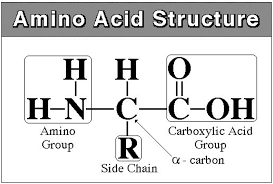What links amino acids together?
What links nucleotides together?
Peptide bonds
phosphodiester linkages
Do plant cells have both mitochondria and chloroplasts? Why or why not?
Yes, because chloroplasts and mitochondria have two different functions, both essential for the cells.
Mitochondria: Place of cellular respiration: Break down organic molecules & convert energy to a form cells can use for work (ATP)
Chloroplasts: Sites of photosynthesis: converts solar energy to chemical energy and makes sugar
Phospholipids and transport proteins in the membrane have both hydrophilic and hydrophobic regions, this means they are
amphipathic
Catabolic pathways __________ energy, anabolic pathways __________ energy.
release, consume
What is the difference between an competitive and noncompetitive inhibitor?
Competitive inhibitors bind to the active site of an enzyme, competing with the substrate
Noncompetitive inhibitors bind to another part of an enzyme, causing the enzyme to change shape
Draw the general structure of an amino acid, labeling its parts.
Amino group
Carboxyl group
Side chain (R group)
(also an alpha carbon in the middle)

Compare/contrast prokaryotic and eukaryotic cells
Proks: No nucleus, no membrane enclosed organelles, nucleoid region, smaller, evolutionarily older, unicellular
Euks: Nucleus, membrane enclosed organelles, larger, unicellular and multicellular
Both: genetic info (DNA), ribosomes, cytosol, cell membrane
What does it mean for a membrane to be selectively permeable?
Only some molecules allowed to pass directly through the membrane
(nonpolar, small molecules)
Other molecules need help
In the cell, the energy from the exergonic reaction of ATP hydrolysis can be used to drive an endergonic reaction.
Overall, the coupled reactions are exergonic
Name each component of the cytoskeleton from largest to smallest. What is each component made of.
Microtubules: grow out from centrosome in animal cells, 9 + 2 structure. All eukaryotic calls, made of tubulin. Functions: Shaping the cell, Guiding movement of organelles (tracks), Separating chromosomes during cell division, Cilia used in motility, Flagella used in motility
Intermediate Filaments:mainly in vertebrates, diverse (include keratins), Persist after cell dies (hair, skin, nails). Functions: Cell shape, Anchorage of organelles (e.g. nucleus), Formation of nuclear lamina, Especially sturdy, more permanent fixtures
Microfilaments: in all eukaryotic cells, made of actin. Functions: Networks shaping the cell, Muscle contraction, Cell motility (pseudopods), Cytoplasmic streaming in plant cells
What dictates the secondary and tertiary structure of a protein?
Primary structure (determined by DNA)
Secondary Structure: Result from H-bonds between repeating constituents of the polypeptide backbone
Tertiary Structure: Primary structure dictates which side chains are available at particular positions, dictating these interactions
Where can ribosomes be found in the cell? What do they do?
Free in the cytoplasm and bound to the rough endoplasmic reticulum
Ribosomes translate sequence of nucleotides in mRNA into amino acid sequence of polypeptides
Why does active transport require energy? What form of energy do cells like to use?
Because the solute/molecule is being pumped against the concentration gradient, from low to high concentrations
ATP
Compare catabolic and anabolic reactions by describing spontaneity, ΔG value, energy absorption/release, endergonic/exergonic, and others
Give an example of each reaction -- hint -- some were discussed in class
Endergonic reactions absorb free energy from surroundings (Change in G > 0), and is non spontaneous (Anabolic, building molecules). Exergonic reactions have a net release of free energy (Change in G < 0), and is spontaneous (Catabolic, breaking molecules).
Anabolic Example: dehydration synthesis reactions
Catabolic Example: hydrolysis reactions
Compare and contrast facilitated and simple diffusion.
Both: passive transport, transports particle down its concentration gradient, spontaneous
Simple: molecule/particle follows concentration gradient and moves across the cell membrane independently. lipids/small hydrophobic molecules only.
Facilitated diffusion: molecules must travel through a transport protein (channel [tunnel] or carrier protein [hold onto passengers and change shape in a way that shuttles them across]). transport proteins usually specific to certain ions and polar molecules they help cross the cell membrane. Example: aquaporins for movement of water across cell membrane.
Draw the general structure of a nucleotide, labeling its parts.
Define what a nucleoside is.
Pentose (5-C) sugar
Phosphate group
Nitrogenous base
(Nucleoside is just sugar and nitrogenous base)

List at all of the components of the endomembrane system in the cell. How are the components connected?
Nuclear envelope
Endoplasmic reticulum
Golgi apparatus
Lysosomes
Vacuoles
Plasma membrane
**Components are either continuous OR connected via transfer vesicles
Where does water move when a cell is placed in an isotonic solution?
No NET diffusion/movement of water.
There still is exchange of water, it is just at equal rates in and out of the cell
What are the ways that enzymes lower activation energy?
Orienting substrates correctly
Straining substrate bonds
Providing a favorable microenvironment
What is the difference between a purine and a pyrimidine?
Which nucleotides are purines and pyrimidines?
Purines: nitrogenous bases that contains 2 carbon nitrogen rings. Adenine, Guanine
Pyrimidines: nitrogenous base that contains 1 carbon nitrogen ring. Cytosine, Thymine, Uracil
C3G
A2T
What are the differences between DNA and RNA?
Sugar type (deoxyribose vs. ribose)
Thymine (DNA) vs. Uracil (RNA)
Double-stranded (DNA) vs. Single-stranded (RNA)
What are purposes of the cytoskeleton?
provide cell shape
internal organization -stabilize positions of organelles and molecules
cell motility- changes in cell location and movements of parts of the cell
intracellular transport- railroad track for moving organelles
A cell is placed in a solution. Here are the associated concentrations:
Solution: 43% water
Cell: 66% solute (eg. glucose)
Draw a picture showing this situation and calculate the remaining concentrations. What type of solution was the cell placed in? Where will the water move and what happens to the cell?
Solution: 43% water, 57% solute
Water: 66% water, 33% solute
Solution is hypertonic to the cell, water exits the cell, cell shrinks
If exergonic reactions are spontaneous, why don’t molecules (and cells) just break apart?
To reach a state at which bonds can break and reform, reactants must absorb a certain amount of initial energy to in order to start the reaction. (activation energy)
What are cristae? Where are they located? What is their purpose?
Cristae: Folds of inner membrane of mitochondria.
Purpose: increase surface area of the inner membrane